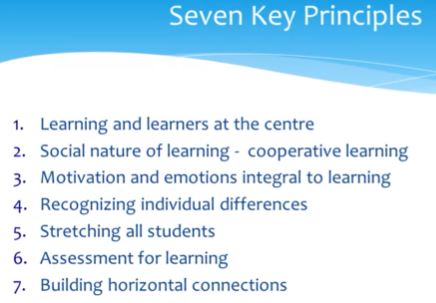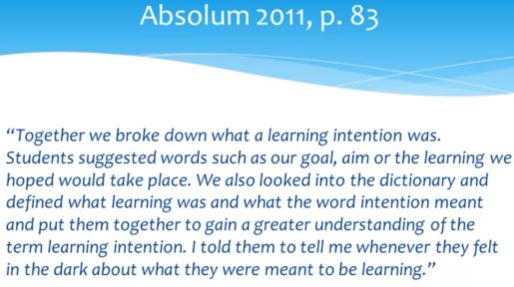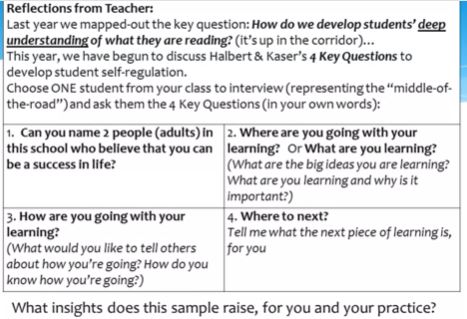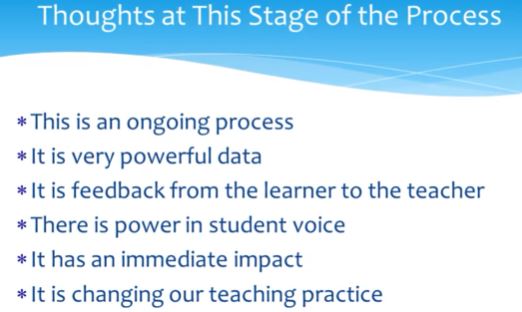#5 Foundations of Teaching for Learning: Planning for Teaching and Learning
Judy Halbert Linda Kaser of Vancouver Island University
repository vs. repertoire
the repository 贮藏室 of all knowledge
this is such an important part of the repertoire (某人的)全部才能of assessment for learning.
Things need to take away:
In the past, and still maybe in many parts of the world, it was alright for school to sort learners, so that some would go on to successful careers, to post secondary education, that others would be asked to leave, that others would fade out and some would just disappear. That's not alright anymore. it's a moral imperative to think about how can we actually create the conditions, where every learner will cross the stage with dignity, purpose and option. The big moral purpose, one of the big moral purposes
Social and Emotional Connections
Michael Fullan's work from Ontario, we had a big investment in secondary student success. And in one of Michael's books he wrote about a strategy - and again, I think it's something reasonably simple - he called it "Two by Ten". And it was this notion that if you have a discouraged or disengaged young person in your class that if, as a teacher, you'd focus on that person for two weeks, ten days in a row, just for two minutes, and engage them in a personal conversation, that for many young people that can turn their lives around.
Mindsets, Trust, Networking and Impact
second one is personal regard, and this is the extent to which we know the people that we're working with. We know what's going on for them in their families. Do we care about them as individuals? Do we have some idea of who is facing personal challenges in any point of time, or do we just say it's one size fits all
Integrity: to do what you see
Competence in core responsibilities: stand up and speak out for any moral violation. if there's a situation in our schools where we know that kids are being hurt, where they're not being treated respectfully, and we stand by quietly on the sidelines and do nothing, the degree of trust will be eroded, and the impact on learners will be negative.
Rosabeth Moss Kanter from Harvard in a book called Confidence, and she said that, leadership is not about walking on water. It's about creating the foundations under the water so that others can.And we think that that's very much a metaphor for teaching as well. That teaching is not about us walking on water as teachers, but as creating the foundations so that our learners can.
Interview 3
https://www.coursera.org/learn/teaching-plan/lecture/qUX9r/interview-3
our three big goals, every learner crossing the stage with dignity, purpose and options,
connect, extend, challenge
I think that it's a false assumption to think that people are comfortable with disagreement and dissonance.
She was talking about science and about how indigenous people that knew that certain plants were good for medicine. I said to her, "Lorna, how did you know what the plants were for?" And I like to tease her, because she looked at me with real exasperation, and she said, "Linda, the plants told us what they were for." this is, you know, a very different world view, and it was certainly a moment of dissonance for me, because I just had never thought about looking at nature in a non-western way.
The spiral of inquiry, maybe it was Lao Tzu, I think, who thought of the spiral of inquiry and the deed is done, the mission accomplished, and return to the people and the people will say at the end of the day, we did it ourselves
Week 1
Video: Lecture 1: Introduction to mindsets for Teaching and Learning
think about how much is curiosity a part of you - because that's the inquiry mindset. And that's foundational to the learning and teaching planning that we're going to be talking about.
Video: Lecture 2: Moral Purpose, Mindset and Hard Goals
The Treasures Within, the big ideas were that we should work together as educators to think about how we could develop young people who knew who they were as individuals that had a personal and social identity that mattered to them, and they called that "Learning to Be". That we need critically - and certainly in our country of Canada, this really matters because we're so multicultural - that we need to learn how to live together in ways that are peaceful and productive and to know how to work in groups and in teams. That, of course, we learned how to know things, and that's one important dimension that may have a rich knowledge base. We also have some experiences with hands on kinds of activities so that we actually learn how to do things and how to accomplish things together. And that richness of four ways of knowing, doing, being, learning to live together, become a part of what we do in school. And it's very interesting some years later, to look at schools, and see if that's really what happens in schools.
The fifth dimension really comes from indigenous people around the world, and I think it's a very, very long oral tradition. And that is, that we need to learn to live in a respectful way with the natural world. And we're seeing more and more evidence that educators around the world are taking from this aboriginal and indigenous world view - the idea, yes indeed, if we re going to have a world worth living in, that we need to add that to the dimensions that we consider.
A second idea that we want to introduce to you in this session is the notion of the difference between smart goals and hard goals.hard goals are those goals in your planning, in your life, that you are heartfelt about. You really, really can embrace these goals. You're animated about them, when you talk about them you come to life and people can feel your passion for it. They're required in the sense of there's an inner conviction that you as a group of teachers, and you yourself believe that you must do this, and they are difficult. So, they are challenging, they're not just small and incremental.
HARD GOALS:
Here's our first one. We want to build classrooms, schools, learning centers where every learner crosses the stage with dignity, purpose, and options.
Here's another big goal that we find challenging. We want every learner in our system to leave our schools more curious than when they arrive. This used to say, we want all learners leaving our schools as curious. However, as a teacher pointed out to us, that's not very ambitious. Curiosity, and the drive to keep learning, we believe, is a lifelong learning strategy that's very, very necessary.
One other example in our setting is we have decided, and I know other countries around the world have done this as well, that we want every young person by the age of around ten to have powerful reading skills. But, we've added an additional dimension which we think, that we're really proud of - and that is, we're trying to develop young people as readers so that they choose to read outside of school. So that they find some joy in the process. So that emotional attachment to reading is something that's a lifelong ability and competence and is built along with the skills at the same time.
Video: Lecture 3: Learning Models
Video: Lecture 4: Inquiry and Professional Learning Designs
Our intention in this session is to underline how important we think curiosity is for teachers and for learners. And how four different forms of inquiry as classroom teachers can be helpful in us getting underneath what the experience of our learners is.
we'd like you to think about narrative, which is what's the story? Appreciative, what are the strengths, talents and interests? Three: critical, whose needs are being met? Whose voice is not being heard? And reflection, how can you build in the opportunity as a classroom teacher to give yourself the luxury of some reflection on a regular basis
Question 4
The authors of Learning – The Treasure Within...
Promote a holistic set of values.
Question 5
Why is it important for teachers to consider the relationship between smart goals and hard goals?
It is a matter of choice which to pursue as these are hugely different in nature.
Question 6
Effort based learning...
Reflects the key aspects of a growth mindset.
Question 7
Choose the best answer. Self-regulated learning...
Requires the learner to manage and maneuver through their own learning by themselves (no)
Involves content knowledge while also learning how to learn. (yes)
Question 8
Drawing on Kieran Egan’s work, suggestions for more powerful learning include:
Creating tasks that allow students to become in-depth experts in an area of learning.
Question 9
An appreciative inquiry would be one in which the teacher...
Gathers evidence to develop an understanding of a learner’s strengths, interests and talents within and beyond the school context.
Question 10
A critical inquiry approach means:
Looking as objectively as possible at the current state of affairs – regarding your staff, your learners, or a program – and determine if it is working or not.
Week 2:
Video: Lecture 1: Weaving the Ways: Wise, Strong and New
three ways forward, and we call these wise, strong and new.
- "Learning requires patience and time".
- story is important
- intergenerational learning.
Video: Lecture 2: Learning Principles
Video: Lecture 3: Assessment for Learning
We've drawn heavily on the work from Dylan Wiliam and Paul Black. It was in 1998 that they're first paper came out, it was called "Inside the Black Box", and it was their work that has helped develop the focus on the strategies that actually make a difference that classroom teachers can do. One of the challenges that we have and that we see with professional development and sometimes we call them the galloping gurus as that people love to say, "research says". And I wonder if any of you have heard that and really understand what is meant behind that. We certainly have and have become quite skeptical about somebody tossing out the term, "research says". We've been influenced and we're thinking hard about the work of John Hattie, from New Zealand. His first book was called Visible Learning.
The other thing that we've found really important about the assessment for learning research is it has the greatest impact on our most vulnerable learners. So, the learners that we're most concerned about, they seem to benefit the most from a focus on assessment for learning. And when we talk about vulnerable learners, we're talking about those who are struggling and those who have a very fixed mindset that they're good at math, they're good at English, and they're reluctant to take challenges because that may contradict their view of themselves. Sometimes those learners, the kids that do well in school, that flourish on getting As, when they hit more challenging - whether it's in grade 11 or grade 12 or post-secondary - they fall apart, because they haven't got the skills to really learn. So, our whole thing is how do we build quality and equity for learners at every stage, and how do we use the assessment for learning repertoire to really strengthen learning in our classrooms.
many teachers are using is called stop lights. So, the learners are provided with a series of red, green and yellow cards. It may be paper cups, it may be a disk. But whatever it is at any point during the class, the, the teacher will say, alright, where are we at? And, if the learners are feeling confident enough that they're with you, they show green, that means that I've got it and I can teach it to somebody else. Yellow, if they're saying, I'm not so sure. And red, if they haven't got a clue what you're talking about. At that point, that's feedback to you, as the teacher, about what you need to do next.
And the fifth strategy is using peers as learning resources for each other. In traditional classrooms, it seemed that the knowledge is in the teacher. In contemporary classrooms, we know that the learners have a lot to contribute to each other, and how do we build in those corroborative learning strategies and time for collaboration so that we're drawing on the strengths of the learners in the group. So, connected to feedback, the learners that are green, that are showing "Hey, I've really got it", that they would know that their job is to find somebody who is showing yellow, work with them, help them understand what's going on while the teacher works with the students who are showing red, that say "I don't get it at all".
the sixth strategy, rather, is around learners owning their own learning, and that's really at the heart of assessment for learning. And that's really everything that we've been talking about in this course is making the shift from the teacher as the as the repository 贮藏室 of all knowledge to developing strategies and approaches where learners are taking responsibility, and developing greater ownership.
Video: Lecture 4: A Focus on Feedback
we can think about the distinction between evaluative feedback and descriptive feedback. So, evaluative feedback provides a value on the appropriateness of the response. Is it right, or is it wrong?Do you get it or do you not? Is it seven out of ten, or two out of ten? We're placing a judgment on the correctness and the value of the work. There's not too much that a learner can do with that, except reinforce their view of themselves as learners.
What we want to do is think more about the kind of descriptive feedback that we provide where learners have an opportunity to act on it. So, we want to provide descriptions of why a response is appropriate. We want to provide descriptions of what they have done well, what they've achieved. We need to provide suggestions of better ways of doing things, and we need to provide prompts to suggest ways students can improve.
And one of the biggest things is that less is more. Again, thinking back to myself as a early-career English teacher, I thought that I was a wonderful teacher if I provided a whole paragraph of suggestions for learners. It was really not such a hot idea, what I should have been doing is, underlining one or two things that they had done quite well, in the piece of writing and provided one, at most two, strategies for what they needed to do next. In our schools, sometimes that's called two stars and a next step. What did you do well and what's your next step? That's descriptive feedback.
Question 1
Moving ahead in wise ways means:
Acknowledge knowledge of .... indigenous people.
Question 2
What is a common element between the First People’s Principles of Learning and Keiran Egan’s work around Imaginative Learning?
Story.
Question 3
Social and emotional learning have important implications for teaching because:
Understanding of these need to be built it into teachers’ planning repertoire.
Question 4
One of the transversal learning principles articulated by the OECD says that we should...
Demand hard work and effort from all learners.
Question 5
Framing a teacher as a coach is important because...
The idea of teacher as coach places the teacher as a helper – someone who will offer feedback and tend to the needs of the learner without judgment.
Question 6
After completing a test, a learner receives a mark back from her teacher at the top of her test. She takes this home to put on her fridge and they start a new unit in class the next day. This mark is characterized as...
Assessment of learning.
Question 7
At the beginning of the year, a teacher informs her class that she will not be giving them marks throughout the year on their assignments. Instead, the teacher says, they will be using feedback from her and their peers, clear co-created criteria, peers as coaches and some other strategies to help them learn. One of her learners, Isabella, lights up when she hears this news. Another learner, Jamaal, suddenly tenses in anxiety. Later, the teacher learns that Isabella had traditionally performed at a below average level in the previous years and Jamaal had traditionally performed near or at the top of the class. Which statement best describes their reactions with regard to this scenario?
Jamaal identifies himself as an “A-student” and feels insecure as he is afraid of how he will operate in an environment without that constant validation and the praise he gets for the high marks.
Question 8
The primary purpose of the ‘no hands up’ protocol as suggested by Black and Wiliam is:
To introduce a different routine in which all learners are expected to participate.
Question 9
The use of traffic lights is a useful tool in a teacher’s repertoire because:
It helps teachers differentiate those who are struggling from those who are not.
Question 10
In our current climate of change and innovation, teachers who are exposed to something that is wise and strong (such as intergenerational learning or formative assessment) and who do not start building it into their own thinking and planning are...
Committing professional malpractice.
WEEK THREE
Video: Lecture 1: Social and Emotional Connections
Video: Lecture 2: Learners Owning Their Own Learning
Video: Lecture 3: Key Questions in Action
Video: Lecture 4: Taking and Inquiry Stance in Planning for Teaching and Learning
WEEK FOUR
Video: Lecture 1: Spirals of Inquiry: An Introduction
Video: Lecture 2: Spirals of Inquiry: Scanning and Focussing
Video: Lecture 3: Spirals of Inquiry: Developing a Hunch and New Professional Learning
Video: Lecture 4: Spirals of Inquiry: Taking Action and Checking
















































No comments:
Post a Comment